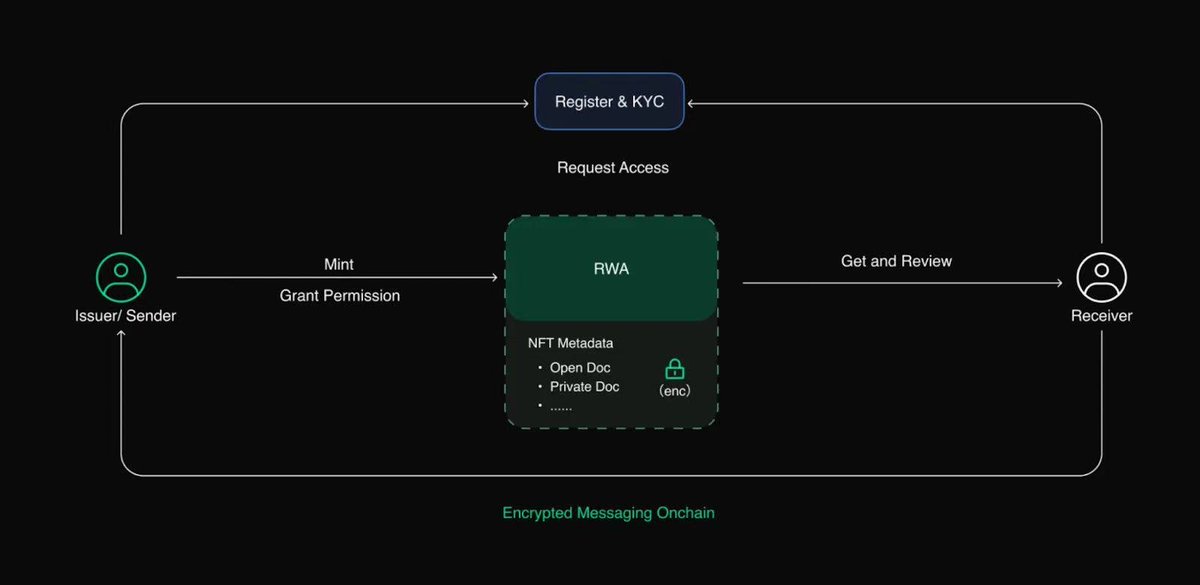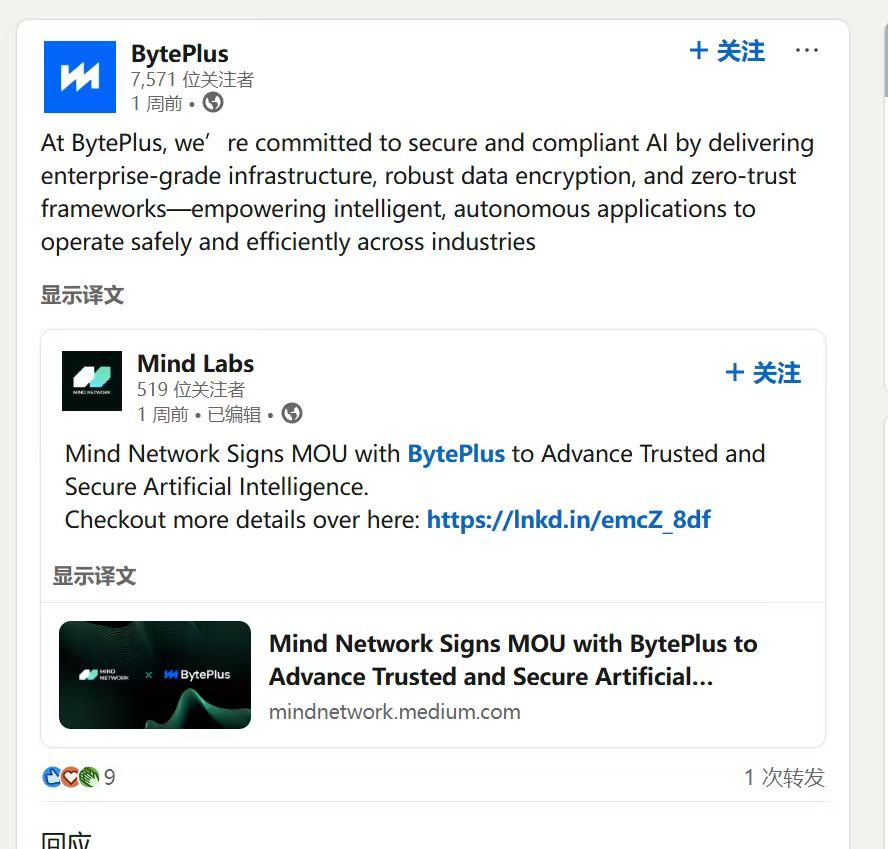I've been busy in the countryside these past few days, feeling a bit overwhelmed. I checked out some news related to RWA and felt like something was missing. Data shows that by the first half of 2025, the RWA market valuation has already surpassed $23 billion, and many leading institutions are busy moving assets onto the blockchain!
But on-chain transactions always feel like "mime communication"—only addresses and amounts are visible, with no contract background or payment purposes, let alone some identity information that needs to be protected.
Then I happened to see the "Encrypted Messaging Onchain" protocol launched by @mindnetwork_xyz in August, which I had been tracking.
It suddenly dawned on me: what blockchain lacks is not processing power, but the "ability to convey information properly." This protocol might just add an "encrypted information channel" to the blockchain, and today I want to share more about it:
First, why does blockchain need to "speak"?
In traditional finance, a cross-border money transfer is not just about sending money; through various systems, it carries a long list of "explanations":
Who paid the money, the recipient's bank, whether the money is for purchasing equipment or a prepayment, what the associated contract number is... These "attached information" are the basis for compliance checks and accounting reconciliations.
But current blockchains, especially some common ones, cannot do this. Transaction data is all public, and who would dare to put sensitive information on it?
Want to add extra explanations? The system itself does not support encryption, so putting it on is like being exposed without clothes; the result is that after a house is put on-chain, privacy documents like property certificates and mortgage contracts cannot be stored alongside it. Want to write the purpose of a cross-border money transfer? Either publicly leak information or only transmit it offline, which negates the meaning of transparency on-chain.
The on-chain encrypted messaging protocol from @mindnetwork_xyz is here to solve this problem.
In simple terms, it can encrypt these "whispers" and package them, either storing them in NFTs on-chain or binding them with transactions, so that only authorized individuals can decrypt and view them.
Moreover, it uses hardcore technologies like FHE (Fully Homomorphic Encryption) and ZKP (Zero-Knowledge Proof), allowing data processing even in an encrypted state, addressing both compliance and privacy concerns.
This technology can be applied in many areas; let me mention a few practical examples:
For instance, when a house is put on-chain, private documents like property certificates and contracts can be encrypted and bound with the property token. When the buyer pays, the blockchain can verify that these documents are genuine, but others cannot see the content, ensuring privacy while preventing alterations.
It's also suitable for cross-border business; customs documents and invoices can be encrypted and put on-chain, with sellers, buyers, customs, and banks each having keys to view only the parts they need, allowing for full traceability without the risk of information leakage.
For more complex financial product settlements, information like interest rates and exercise conditions can be encrypted and included in transactions, allowing smart contracts to calculate money in an encrypted state, meeting privacy requirements while enabling automatic execution.
In short, it allows blockchain to "speak clearly" like proper communication, not just transferring numbers.
Of course, just talking about technology is not enough; the key is whether it can be truly utilized.
What makes @mindnetwork_xyz seem reliable to me is its actions in the Web2 space, not just playing in the crypto circle.
It first signed a cooperation intention with BytePlus, a subsidiary of ByteDance, becoming the first Web3 company to enter the Byte ecosystem.
Byte's Feishu has 40 million users, and COZE is an AI assistant platform; now Mind Network's technology has been integrated into COZE.
When ordinary users use COZE's AI assistant, all the data they input is encrypted throughout, and the platform cannot see the original content, but it can still ensure that the results have not been altered (this is backed by their MCP protocol, specifically designed to verify the authenticity of AI outputs).
Earlier, it also collaborated with Alibaba Cloud, being the first integrated FHE project in DeepSeek, which can be found on DeepSeek's GitHub. Mind Network's encryption service is used to protect the AI inference process, and it is now actually used in production environments.
The willingness of these Web2 giants to collaborate with it indicates two things:
First, FHE technology can indeed solve their problems (like the privacy issues of AI data);
Second, @mindnetwork_xyz's ability to implement is reliable, not just empty promises. After all, being able to serve 40 million users of Feishu and the commercial scenarios of Alibaba Cloud means that the technology's stability and compatibility are definitely up to par.
In addition to this new protocol, they have many other impressive offerings:
In fact, the on-chain encrypted messaging protocol is just one part of @mindnetwork_xyz's entire ecosystem. Their core is FHE technology, around which they have developed several products:
There is one called Agentic World, which is an AI agent network with 60,000 AI assistants, coordinated by the $FHE token.
These AI assistants communicate and process data in an encrypted manner, ensuring that user information is not leaked, and they can verify each other's "identities" to prevent impersonation.
There is also an FHE Bridge, a cross-chain tool based on FHE, supporting hidden addresses (the kind mentioned by Vitalik). When transferring, the recipient's address is encrypted, protecting privacy. Recently, it was announced that it would integrate with Circle's CCTP, allowing USDC cross-chain transactions to use this technology, making institutional transfers more secure.
Additionally, there is MindX, an encrypted AI chat tool that uses DeepSeek's model (after all, the two companies have a deep collaboration). The content you chat with the AI is encrypted throughout and stored in decentralized storage, so the platform cannot see it, making it suitable for handling sensitive information.
These products share a common feature: they all practically utilize FHE technology, not just staying on paper.
The project definitely has potential; FHE technology has been mentioned several times by Vitalik, and the industry believes it is the next generation of privacy technology, with more flexible application scenarios than ZK.
@mindnetwork_xyz is the first project to apply FHE on the mainnet, and with support from Web2 partners like ByteDance and Alibaba Cloud, its current valuation is not high (having raised $12.5 million in two rounds, with a valuation of about $100 million, and the investors' shares have not yet been unlocked). If it can get listed on Binance's spot market in the future (after all, it is currently on Binance Alpha with a transaction fee of 0.01%, and I tried a $1000 transaction with a loss of about $1), the potential for growth is worth watching.
Risks must also be mentioned: FHE technology is still developing, and the actual scenarios where it can be used need to be cultivated gradually. Moreover, the collaboration with Web2 giants has many hurdles to overcome from signing to large-scale implementation. But then again, which new technology doesn't go through this step by step?
In summary, @mindnetwork_xyz's on-chain encrypted messaging protocol essentially fills a gap for blockchain—allowing it to safely "discuss complex matters."
This is indeed needed in areas like property on-chain and cross-border money transfers, which require compliance while ensuring privacy.
More importantly, it is not just spinning in the Web3 circle but actively connecting with Web2 platforms like ByteDance and Alibaba Cloud, which is the way for technology to be truly utilized.
After all, what is truly valuable is not just issuing a token for speculation, but solving real-world problems.
If you're interested, you can check out their Twitter @mindnetwork_xyz or try out the applications on COZE: how the AI assistant works, and keep an eye on $FHE.
Show original

10.07K
87
The content on this page is provided by third parties. Unless otherwise stated, OKX TR is not the author of the cited article(s) and does not claim any copyright in the materials. The content is provided for informational purposes only and does not represent the views of OKX TR. It is not intended to be an endorsement of any kind and should not be considered investment advice or a solicitation to buy or sell digital assets. To the extent generative AI is utilized to provide summaries or other information, such AI generated content may be inaccurate or inconsistent. Please read the linked article for more details and information. OKX TR is not responsible for content hosted on third party sites. Digital asset holdings, including stablecoins and NFTs, involve a high degree of risk and can fluctuate greatly. You should carefully consider whether trading or holding digital assets is suitable for you in light of your financial condition.

